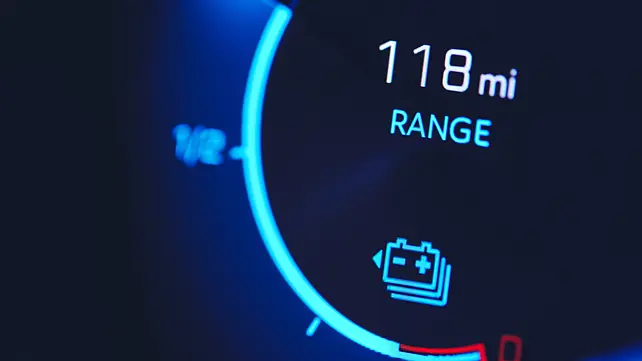
One of the most well-known fears among electric vehicle users in India is “range anxiety” – a fright that the vehicle would run out of charge before they reach their destination. Why is the range in an EV so critically examined? This is linked to the energy density of the EV battery.
Energy density is simply defined as the amount of energy stored in a given mass or volume. There are two types of energy density in EVs with a specified battery pack. They are energy per unit mass and energy per unit volume. These two types of energy densities indicate the weight of the battery and the amount of space it occupies in the EV given its energy rating.
When compared to fossil fuels, the energy density in Li-ion batteries is much lesser, which essentially leads to range anxiety in EV users. The range of any vehicle is decided by its fuel’s amount of stored energy and the rate at which this energy is depleted during usage. An EV’s range, which is decided by the battery, is influenced by various factors that may or may not be in a user's control. Thus, to maximise range, one needs to know how these factors affect the range.
The parameters that affect the EV range that is under the user’s control are acceleration & braking, travelling at high speeds and usage of regenerative braking. Generally, harsher accelerations, harsher braking and higher speeds decrease the range. And usage of the regenerative braking present in EVs increases the range.
Acceleration & Braking
Harsh accelerations reduce the state of charge (SOC) faster than smoother accelerations. These attributes to several energy losses, which occur during harsh acceleration such as frictional losses. In such harsh accelerations, electric motors provide larger torques to the shaft and gears, which causes high frictional losses in the gears as heat (which is a waste).
Under harsh accelerations, the battery has to supply additional energy to the motor. It sends larger currents to achieve the desired speed within a short period of time. Thermal losses occur when motor windings are exposed to these large currents for a long period of time.
During harsh braking, the battery does not consume energy. But, the brake pads apply a frictional force to the wheels to halt them. This contributes to an indirect waste of charge.
High Speed
Air resistance negatively impacts the energy consumption of all vehicles, including EVs. But it is most prevalent at high speed. At all speeds, there exists a frictionally-induced rolling resistance. It exists between the tyres and road, generating wasted energy as heat. This resistance adds to the air resistance, thus depleting more energy. The Department of Energy states that a decrease of 15 km/h in the speed used in an EV can decrease energy consumption by more than 14%.
Regenerative Braking
In EVs, the OEMs create a mechanism wherein the motor will automatically generate reverse torque from a free-spinning wheel. This mechanism charges the battery by a small amount. This is regenerative braking. With every regenerative braking, the range increases every time.
Thus, regenerative braking presents an opportunity to increase the state of charge (SOC). Generally, the most efficient way to drive the EV is to adopt a smooth driving style. This involves utilising regenerative braking effectively.
Connected Technologies
One of the ways to increase the range of EV batteries is to use a connected vehicle platform and analyse various vehicle data that transmit over the air (OTA) via telematics devices fitted inside the standard vehicle. Some of the potential data that can be acquired is the location of the vehicle, acceleration and braking, instantaneous speed, current SOC, energy consumed, energy regenerated, etc.
After acquiring this data, connected vehicle platforms uses their expertise in telematics, IoT, analytics, automotive domains, data sciences to monitor the driving behaviour of EV users and gather meaningful insights.
With advanced artificial intelligence and machine learning algorithms, these connected vehicle platforms can give an indication to the user on the ideal speed, acceleration, braking and extent of regenerative braking they should follow on a particular road to maximise their range. This is because each type of road will have a different amount of traffic congestion and topography that influences the driving behaviour of an EV. These platforms can also give a real-time prediction of the range given the current SOC of the user based on their driving behaviour.
In Conclusion
Driving behaviour and the road type are crucial factors in the maintenance of EV battery life. One can use the data insights in a right way to understand the driving parameters, which will help in increasing the battery efficiency and longevity.
About the Author: Venkat Nathan is the Founder & CEO of Nesh LIVE, a comprehensive connected vehicles platform in SaaS model (Software-as-a-Service) for businesses in the automotive industry, both OEMs and auto component suppliers or service providers, to benefit from collection & analysis of vehicle and driver behaviour data.